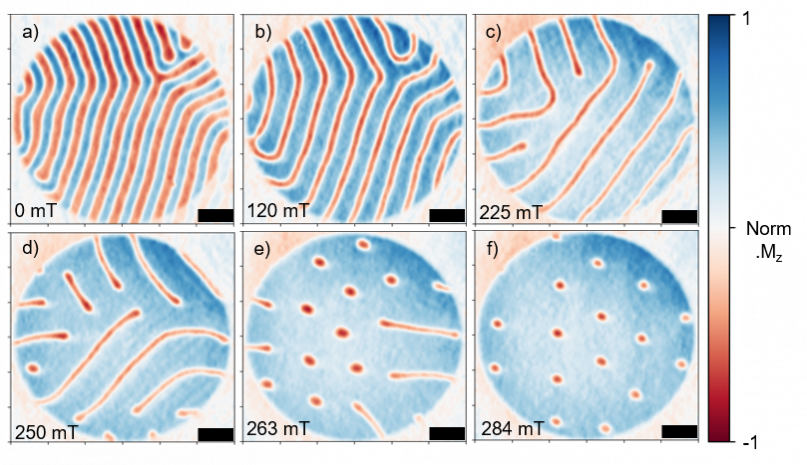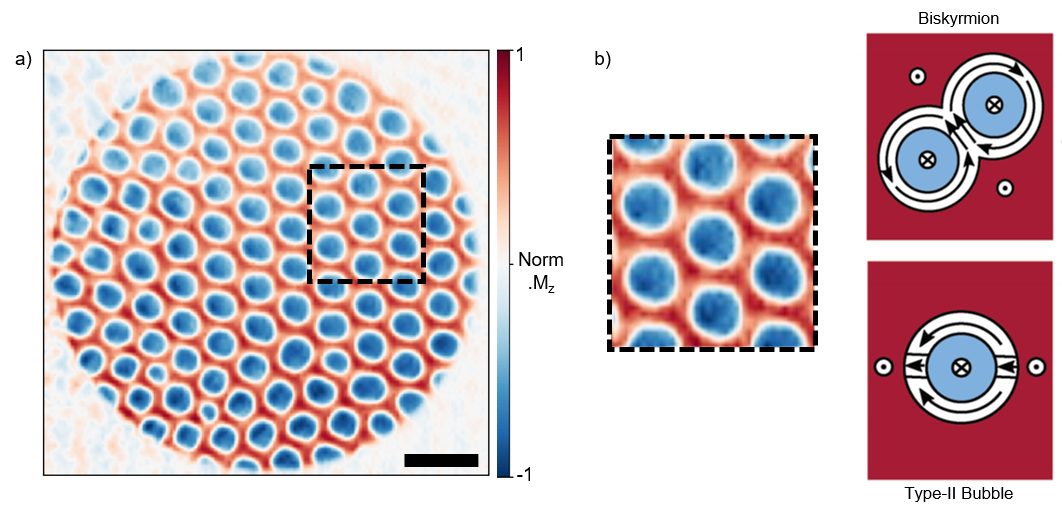Magnetic skyrmions are nanoscopic vortices of magnetisation, which promise exciting new applications in spintronic devices due to their novel topological and transport properties.
In a recent successful collaboration between the team at the SEXTANTS beamline, The UK Skyrmion Project and Exeter University, scientists have used resonant coherent x-ray holography to investigate the bound-pair skyrmion state known as biskyrmions. High-resolution holographic images of the magnetic state were generated, leading to the conclusion that biskyrmions might have been misidentified magnetic bubbles all along.
Initial reports of the biskyrmion texture all came from measurements performed by Lorentz transmission electron microscopy (LTEM), a commonly used electron imaging technique, which is sensitive to transverse components of magnetic flux density. This approach boasts a high spatial resolution of approximately 2 nm, however does not directly image a sample’s magnetisation.
In order to directly probe the biskyrmion texture in this study, a holographic technique known as HERALDO (Holography with Extended Reference by Autocorrelation Linear Differential Operator), was employed (Fig. 1). Magnetic contrast was produced by exploiting x-ray magnetic circular dichroism (XMCD), in which the x-rays produced by the SEXTANTS beamline are polarized such that they become sensitive to magnetisation parallel with the beam. By transforming the holographic scattering pattern, a reconstructed real space image of the magnetisation is attained. This holography method has the advantage of fast collection times and an improved resolution, with an impressive 23 nm resolution being achieved.

Figure 1: A schematic for HERALDO. The difference in the interference of opposite circularly polarized coherent x-rays of passing through the sample and a blank reference aperture are recorded, forming a holographic diffraction pattern. By performing differential filtering and apply the fast Fourier transform algorithm, a holographic image of the magnetic state is reconstructed.
The main result of this study is that through a collective analysis of x-ray holograms, LTEM images and micromagnetic simulations, previous reports of biskyrmions can be accounted for as a misidentification of type-II magnetic bubbles, which do not share the topological winding of a skyrmion (Fig. 2).

Figure 2: a) An x-ray hologram of a lattice of objects in the reported ‘biskyrmion’ state. The scale bar represents 500 nm.
b) A comparison of the hologram with schematics of biskyrmions and type-II bubbles.
It has been shown that it is likely the biskyrmion is not a stable magnetic configuration and it is not necessary to invoke it in order to explain the previous measurements. By varying the temperature and magnetic field applied to the sample, many different magnetic states were examined, however none matched the expected twin-core structure of a biskyrmion (Fig. 3.).

Figure 3: Series of x-ray magnetic holograms following a magnetic field sweep at room temperature. Magnetic stripes contracting into bubbles can be seen. The scale bar represents 500 nm.
In a broader context this work has implications for the stability of certain topological magnetic states, but has also shown resonant coherent x-ray holography to be a robust and reliable magnetic imaging technique. With the possibility of also recording dynamic behaviour holographically, the future of magnetic scattering at Soleil is looking bright and bubbly.
UK Skyrmion Project, EPSRC Programme Grant (EP/N032128/1), and the OpenDreamKit Horizon 2020 European Research Infrastructures project (#676541) are acknowledged for their financial support.
